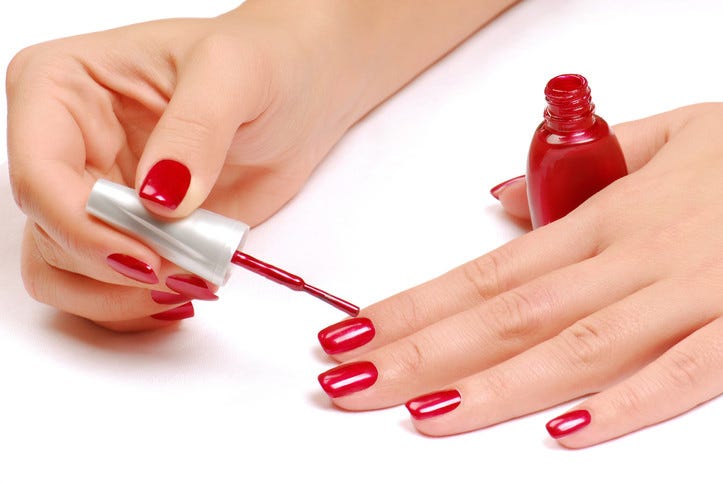The Effect of Nail Polish on Human Health
Written by Pooja Gopinathrao
Do you love painting your nails? The different colors, types of manicures, and aesthetics?! They look so beautiful. However, have you ever pondered its effects on your health? If you’re at a salon right now, I’m sorry, because there are numerous health effects of just getting your nails done.
The Science Behind Nail Polish
Traditional nail polish is painted a few times on your nails and air-dried. There are many ingredients in nail polish, but the basics are solvents, polymers, pigments/colorants, and other additive ingredients. Solvents allow the drying process by evaporating and leaving a solid, colored film behind on the nail. The polymers form a glossy film on the nail once the nail polish dries (contributes to its longevity). Plasticizers are additives that allow the nail polish to be flexible. The nitrocellulose hardens after the solvent (s) evaporates.
Traditional Nail Polish
Fortunately, traditional nail polish with air-drying is less dangerous. Leaving your nail polish on for long periods can cause brittle nails. This can lead to other issues as brittle nails can't keep out the bacteria and fungus. Secondly, applying and removing nail polish can damage your skin, but also leave you with dry/brittle nails. This is because nail polish removers often contain harsh chemicals. Some chemicals may also include isopropyl acetone, methyl ethyl ketone, and n-methyl-pyrrolidone which have a history of causing reproductive harm and organ toxicity. To reduce the dangers of nail polish, you can always moisturize your fingers and fingertips and take breaks from painting your nails.
Gel Polish
Options like gel polish last way longer than traditional nail polish. However, gel polish must be “cured” under a lamp (the polish hardens very fast) This is called photopolymerization, the liquid absorbs energy from UV and becomes a solid. Exposure to UV light increases the risk of skin cancer, as ultraviolet light can cause cellular damage and aging. There hasn’t been an experiment done on humans, but there has been an experiment where human and mouse cells had been exposed to UV light from nail dryers. It was observed that after 20 three consecutive 20-minute sessions, 65% to 70% of the cells had died. Many dermatologists say using a UV curer every other week itself can be very harmful and risky. Dermatologists also say that fingerless gloves and applying a waterproof sunscreen (at least 50 SPF) before a nail appointment do offer some sense of protection. To avoid that, there are LED light lamps that only emit some UV light. Another issue to be concerned about with gel nails is that the removal process can destroy your natural nails.
Powder Dip Polish
The last type of manicure you can get is a powder dip polish. Generally, the only issue with this is rough removal. Many use an electric file that damages your nails and cuticles. Fortunately, these manicures don’t need UV lamps, as they are just bonding polish with acrylic powder. However, the nails are then dipped in powder or brushed onto the nail. This does raise a question of sanitation, as these jars are used for multiple people- building a well of all types of bacteria and fungi. These manicures aren’t the most hygienic and avoiding them would be best.
Takeaway?
Doing nails looks beautiful and is a form of self-expression, but it comes with a cost. Regular manicures and pedicures with harsh chemicals can weaken your nails, risk fungal infections, ingrown nails, allergic reactions, and affect your skin cells giving way to skin cancer. Many don’t consider nails as an important part of the body, but they reflect your overall body health and prevent infections.
References
“A Look at the Effects of Nail Polish on Nail Health and Safety.” Harvard Health, 21 Nov. 2019, www.health.harvard.edu/blog/a-look-at-the-effects-of-nail-polish-on-nail-health-and-safety-2019112118231.
Bem, Marian Newman. “The Science Behind Regular Nail Polish: How Does It Work?” NailKnowledge, 9 Oct. 2023, nailknowledge.org/blog/the-science-behind-regular-nail-polish-how-does-it-work.
“Nail Polish Removers - Safe Cosmetics.” Safe Cosmetics, 24 May 2022, www.safecosmetics.org/chemicals/nail-polish-removers/#:~:text=Isopropyl%20acetone%2C%20methyl%20ethyl%20ketone,reproductive%20harm%20and%20organ%20toxicity.
“These Dermatologists Say They Don’t Get Gel Manicures as Research Hints UV Nail Dryers May Damage DNA.” NBC News, 24 Jan. 2023, www.nbcnews.com/health/health-news/dermatologists-avoid-gel-manicures-uv-nail-dryers-rcna67003.
Written by Pooja Gopinathrao from MEDILOQUY


